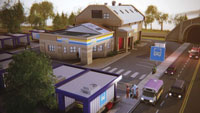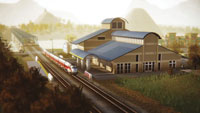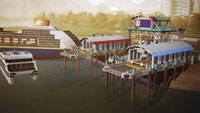
SimCity Strategy Guides
 Mass Transit Tips & Problems
Mass Transit Tips & ProblemsMass transit can be used effectively to reduce traffic in your city and generate tourists, it can also become costly especially if it is not used appropriately.
The following sections can be found in this article:
 An Overview of Mass Transit
An Overview of Mass TransitMass transit can be a mixed blessing. It can help reduce traffic in a city, but only if that traffic is actually moving. If your entire city is gridlocked then it is unlikely that introducing mass transit will help significantly, if at all. Mass transit plus tourists can often be noticably worse than just residents and no mass transit.
Although mass transit vehicles carry more Sims per vehicle, most do still use the road network to some extent, either by traveling along the road like buses, or slowing traffic at junctions and crossings like streetcars and trains.
Because mass transit is largely for the benefit of low wealth Sims, you can help reduce traffic problems by confining transit stops to areas where such Sims occur. If an area develops to a higher wealth level the chances of it's residences using mass transit drop. Empty buses making unnecessary stops to collect very few or even no passengers, will only worsen traffic in high wealth areas so it's best to save your simoleons and delete them.
 Buses
Buses
Buses are the staple transport of low wealth areas, in contrast high wealth Sims dislike bus stops nearby, so focus the majority of your bus stops in poorer areas.
One important thing to remember with bus transit, is that Sims do not 'cross the road' the way we do. If they want to get to a location on the other side, they will travel to the nearest end of the road, cross at the intersection and then go back down the other side (or update their pathfinding and go somewhere else entirely). Lets just assume that Sims have really strict laws on jay walking! To make your bus stops more effective, it is a good idea to place them in pairs, one on either side of the road.
 Bus stops work best in pairs to service both sides of the road
Bus stops work best in pairs to service both sides of the roadBoth regular transit buses and school buses share a common problem which is they block the road when they stop. This means traffic stacking up behind them on narrow roads. Of course you could upgrade the road network around busy residential bus routes, but this will can lead to increased density and population growth which may just makes the traffic problems worse of existing zone imbalance gets more exaggerated.
For more information:
 Bus stops are most effective in low wealth areas. In contast high wealth Sims dislike having bus stops near their homes and will not use them
Bus stops are most effective in low wealth areas. In contast high wealth Sims dislike having bus stops near their homes and will not use themThe park and ride stop allows Sims to drive to it in order to catch the bus. It has a larger area of influence than the regular bus stop and doesn't suffer from the 'not crossing the road' problem because it serves road rather than pedestrian traffic. Placing park and ride stops in busy areas and near isolated transport buildings, like train stations, airports etc, will encourage lower wealth Sims to use the bus to get to places that are near city bus and park and ride stops. It is worth remembering that Sims will walk up to 400 meters before driving to get to a location, including a mass transit stop. Since the whole city is only 2000 meters along it's width and depth, you don't need many park and ride stops in your city to provide effective coverage.
 Streetcars
Streetcars
These offer the best compromise between efficiency and availability but they are not without their drawbacks.
Although streetcars use the center lane of the high density streetcar avenue, they do still interact with regular vehicle traffic on junctions and corners so can lead to additional traffic stagnation. They are also expensive to upgrade the road network, the depot is large, reduces land value and doesn't come with many cars.
One complication of streetcars is that the high density avenue requirement allows for high density buildings. This can lead to a considerable disruption to the balance of your RCI and zoning as upgrading avenue networks for streetcars can suddenly spawn a lot of high density buildings if other conditions favour it. Of course it might be that you actually want high density buildings, but it's important to look closely at what might be affected on your streetcar route before you rush in and upgrade in an effort to try and fix ttraffic problems.
For more information:
 Upgrading medium avenues for streetcars is expensive and can cause huge fluctuations in zone balance and demand BUT all Sims like the Streetcar!
Upgrading medium avenues for streetcars is expensive and can cause huge fluctuations in zone balance and demand BUT all Sims like the Streetcar! Trains
Trains
Using railways to move Sims around within a city has both advantages and disadvantages. On the plus side railways have high capacity and are fast so it's possible to move high volumes of Sims efficiently.
On the negative side the stations have a small area of influence, the same size as a streetcar or bus stop. They are also costly to build and can cause traffic problems if you don't use bridges /tunnels to keep them from crossing your road network (mercifully this is now an option since this article was originally written).
This play-through video demonstrates some of the benefits and challenges of creating an in-city railway system:
Overall trains are arguably best suited for connecting to the region for moving specialization goods or tourists. When it comes to moving goods, creating a regional rail network can be a real city-saver if your roads are gridlocked. Trains can bring in large numbers of tourists if your city has attractive buildings (shops, gambling or culture), but this can often lead to local traffic choke points as they use the roads to travel to attractive buildings from the train station. Having dead-end roads exiting from train stations which lead only to tourist hotspots can help to divert this traffic away from your regular residential traffic to a certain extent, but may make it difficult for tourists to reach commercial districts in your city. Regardless it is a good idea to plan how to bring tourists from your train station to your tourist attractions before you add the majority of your road network. It's very easy to wind up with the train station tucked away in a corner as an after-thought, making it pretty useless for tourists and commuters alike.
For more information:
 Ferries
Ferries
With the ferry you're unlikely to see much use in the early development phase of a city even with high commercial demand and some tourist generation.
This is because ferries are favoured by high wealth tourists which don't tend to appear until a city has a well established tourist specializations such as attractions, higher wealth casinos and hotels in high wealth commercial areas.
They will also be much more effective when other connected cities in the region also have ferry ports too, so it's something you may need your neighboring Mayor's to invest in before it works at full capacity.
 Ferries work best when there is high wealth tourist demand in your city and other ferry ports in connected cities in the region
Ferries work best when there is high wealth tourist demand in your city and other ferry ports in connected cities in the regionMy recommendation is to plan where you'll place your ferry port and access roads (keeping in mind bringing in those tourists from the port to your attractions), but don't place them until you have established your tourist attractions as a workable business.
For more information:
 Planes
Planes
Planes can increase high wealth tourism and allow you to ship freight from trade storage depots, however they take up a lot of space and cause a lot of unhappiness in nearby residential areas by reducing the land value and generating a lot of pollution.
Finding enough room to place the airport and allow for expansion (adding more runways) AND keeping the airport directly connected via short distances of road to trade depots, and making those roads clear enough that supply trucks can get through, is a challenge! It is definitely something that you want to try and plan for from the early development stage of your city rather than trying to cram it in to a carefully balanced zoning setup later on. As with the ferries and train stations, they are more effective when you have airports in other cities. They will also benefit from having buildings and attractions in your city that appeal to medium and high wealth Sims.